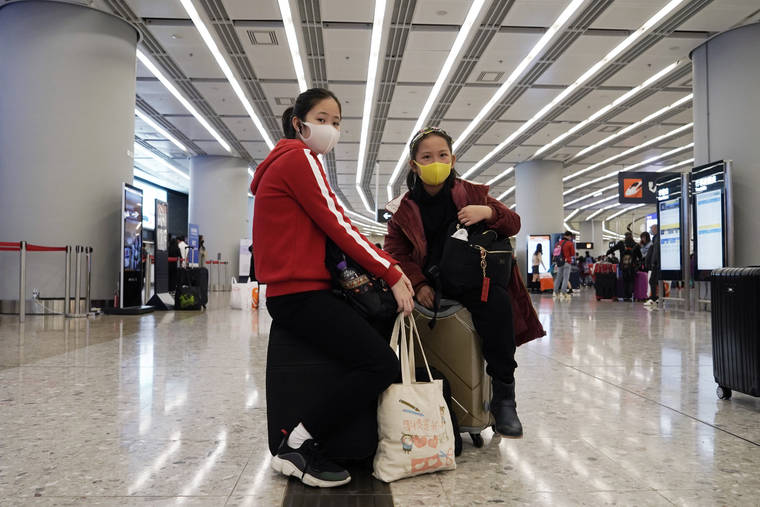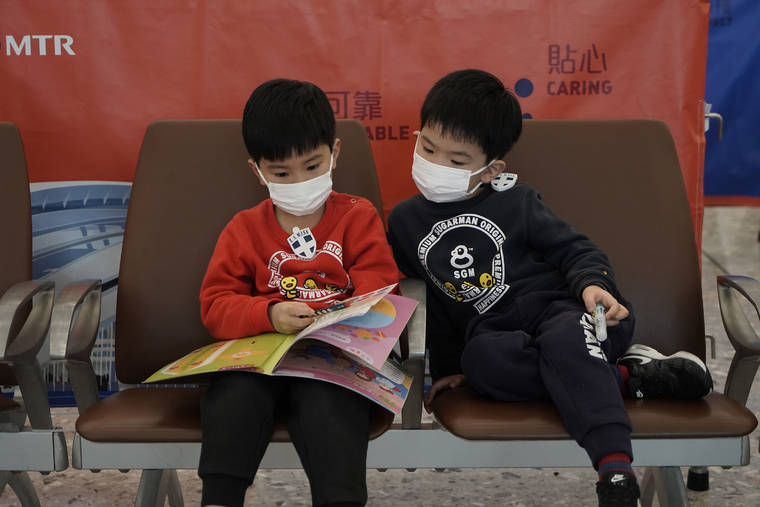DOH urges vigilance, not panic as deadly coronavirus spreads

A health official scans the body temperature of a passenger as she arrives at the Soekarno-Hatta International Airport in Tangerang, Indonesia, Wednesday. (AP Photo/Tatan Syuflana)

Passengers wear masks to prevent an outbreak of a new coronavirus in the high speed train station, in Hong Kong, Wednesday. The first case of coronavirus in Macao was confirmed on Wednesday, according to state broadcaster CCTV. The infected person, a 52-year-old woman, was a traveler from Wuhan. (AP Photo/Kin Cheung)

In this Tuesday photo released by China’s Xinhua News Agency, a staff member watches a screen showing temperature scans of passengers at Wuhan Tianhe International Airport in Wuhan in southern China’s Hubei Province. The number of cases of a new virus has risen to 440 in China and all the deaths had been in Hubei province, home to Wuhan city where the first illnesses from coronavirus were reported in late December, Chinese health authorities said Wednesday. (Xiao Yijiu/Xinhua via AP)

Passengers wear masks to prevent an outbreak of a new coronavirus in the high speed train station, in Hong Kong, Wednesday. (AP Photo/Kin Cheung)

John Wiesman, Washington state Secretary of Health, speaks Wednesday during a news conference in Shoreline, Wash. Wiesman and other officials spoke about the ongoing response after a man in Washington state traveled to China and contacted the 2019 novel coronavirus. (AP Photo/Ted S. Warren)

Department of Helath Director Dr. Bruce Andreson speaks during a Wednesday press conference flanked by state Epemiologist Dr. Sarah Park and Dr. Jim Ireland, Aircraft Rescue and Firefighting medical director, in Honolulu. (Photo from video/Special to West Hawaii Today)
State health officials are urging Hawaii residents to be vigilant but not to panic after a deadly new virus from China reached the U.S. West Coast in recent days.
State health officials are urging Hawaii residents to be vigilant but not to panic after a deadly new virus from China reached the U.S. West Coast in recent days.
“The risk of infection here in Hawaii remains very low in our estimation,” Department of Health Director Dr. Bruce Anderson said during a Wednesday press conference, flanked by state epidemiologist Dr. Sarah Park and other officials. “The confirmation of limited person-to-person transmission, though, does raise some concern.”
The department, he said, is “actively looking at” and monitoring the outbreak, which he described as “rapidly evolving and escalating.”
“I want to stress that there are no cases or an active response to a case or investigation,” Park said. “A lot of what we’re doing right now is preparing.”
That means making sure the public is informed and health care providers are aware of the situation and know what to do if a patient presents himself or herself with signs of the illness.
“Especially to know (what to do) in terms of collecting a detailed travel history specifically from Wuhan, China, because while we do not have direct flights to Hawaii from Wuhan, we do know true of every traveler out here, that we get people from all over the world at some point that make their way here,” she said.
Keeping the community aware of the risk is also important, she said, stressing that as of right now the Centers for Disease Control and Prevention (CDC) has identified travel to Wuhan, China, as the only risk.
“We’ve heard of these cases in other countries that are popping up, including now in Washington state, I want to stress that those are imported cases. There’s no sign of active transmission going on in those areas,” she said. “Disease transmission is really, right now, limited to China — and specifically, as far as we understand it, Wuhan, China. But again, it’s evolving and we’re monitoring it very closely.”
The number of new cases has risen sharply in China, the center of the outbreak, the Associated Press reported Wednesday. Thus far, 17 people have died, and all were all in Hubei province, where the outbreak emerged in the provincial capital of Wuhan late last month. Wuhan authorities said the province has confirmed 444 cases, which would bring the national total to more than 500.
The illness comes from a newly identified type of coronavirus, a family of viruses that can cause the common cold as well as more serious illnesses, such as the SARS outbreak that spread from China to more than a dozen countries in 2002-03 and killed about 800 people.
Authorities in Thailand on Wednesday confirmed four cases: a Thai national and three Chinese visitors. Japan, South Korea, the United States, Taiwan and Macao — a former Portuguese colony that is a semi-autonomous Chinese city — have all reported one case each. All of the ill were people from Wuhan or who recently traveled there.
“Many patients have reported some link to seafood and the animal market in Wuhan city, but there are growing numbers of patients that are not linked to any markets, and it does suggest that there may be some person-to-person transmission occurring at least in that part of the world,” Anderson said.
The U.S. patient, a man in his 30s who traveled to China in November, was doing well in an isolation unit in a hospital north of Seattle. He returned to Washington state Jan. 15, before the start of U.S. airport screening, health officials said. It was reported Wednesday night that he’d had close contact with 16 individuals after the trip.
Park said Hawaii residents can learn from that man’s actions upon feeling the onset of illness after returning from the country and contacting his health care provider.
“It behooves all of us in the community to be aware so that if you do travel, you know what your risks are,” she said. … “If you look at that situation, that is exactly how we hope our community also responds, and that’s what we’re working toward.”
The state epidemiologist also recommended getting the flu vaccine to those who haven’t already because it can facilitate diagnosis should someone suspect they have the virus.
“If you get vaccinated, that eliminates one part of the equation,” she said. “It just helps your health care provider as well as your community.”
Concerns over the spread of the virus has prompted five airports in the U.S., including in Los Angeles, San Francisco, Chicago, Atlanta and New York, to conduct expanded entry screenings of travelers arriving from Wuhan, China.
“While the screening may catch those who are actively ill, it won’t catch those people who may still be incubating the virus,” said Park, noting that officials saw this occur during the 2019-20 pandemic. “Basically, people travel and they are incubating it. They seem fine, they are fine by all intents and proposes. They arrive home and then start to get become ill.”
In Hawaii, the Department of Health said its “passive airport screening for ill arriving international passengers with influenza-like illness” continues.
“This surveillance program has been conducted under our direction in partnership with Airport Medical, DOT/Airports, CBP, and the Honolulu Quarantine Station since October 2005,” the department said in an email.
Hawaii has no direct flights arriving from Wuhan, China, according to state Department of Transportation spokesman Tim Sakahara who noted Honolulu’s Daniel K. International Airport has direct flights arriving from 20 international cities, including a nondaily flight from Shanghai to Honolulu.
But that doesn’t mean someone who’s traveled to that region won’t reach Hawaii, a place Anderson called the “crossroads of the Pacific.” Though it’s not yet determined for the coronavirus at hand, Anderson said other viruses tend to have a two-day to two-week incubation period.
“In that two-day to two-week period, of course, someone could travel a long way, they could go through several airports easily and get to Hawaii. Although no flights are coming here directly, we are concerned about travelers coming back to Hawaii eventually, carrying the virus with them,” he said, “and hopefully if they do get ill we’ll be able to identify them quickly and isolate them so they don’t spread the disease to anyone else.”
He also urged people keep things in perspective.
“There’s been one confirmed case in the United States, in Washington state, one individual who brought the disease with him back to the United States. There are tens of thousands of cases of flu every year and thousands people die from the flu every year,” Anderson said. “We haven’t had any deaths here in the United States from the virus; flu by far is having more impact on the community than this has or is likely to have going forward.”
Between October, the typical start of the flu season, and Jan. 4, Hawaii has recorded 2,633 cases of influenza with influenza A accounting for 58% of the cases, according to the Jan. 17 Hawaii Influenza Surveillance Report. Some 168 deaths have been related to pneumonia or influenza. No pediatric deaths have been reported.
The CDC estimates that so far this season there have been at least 13 million flu illnesses in the United States prompting 120,000 hospitalizations resulting in 6,600 deaths, including 39 influenza-associated pediatric deaths.


